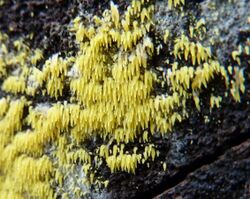Biology:Mucronella
| Mucronella | |
|---|---|

| |
| Mucronella bresadolae | |
| Scientific classification | |
| Kingdom: | |
| Division: | |
| Class: | |
| Order: | |
| Family: | |
| Genus: | Mucronella Fr. (1874)
|
| Type species | |
| Mucronella calva (Alb. & Schwein.) Fr. (1874)
| |
| Synonyms[1] | |
| |
Mucronella is a genus of fungi in the family Clavariaceae. Species in the genus resemble awl-shaped teeth that grow in groups without a common subiculum (supporting layer of mycelium).
Taxonomy
The type species was originally named Hydnum calvum in a collaborative effort by the German botanist Johannes Baptista von Albertini and the American Lewis David de Schweinitz in 1805.[2] Swedish mycologist Elias Magnus Fries transferred the species to the newly described genus Mucronella in 1874.[3]
Molecular phylogenetic analysis suggests that the genus is monophyletic, and is sister to the remainder of the Clavariaceae,[4] confirming earlier suspicions that the taxa were phylogenetically related.[5] It had previously been placed in the Russulales due to its amyloid spores, and its morphological similarity to some members of genus Hericium.[4]
Description
Fruitbodies of Mucronella species resemble hanging spines; they occur singly, scattered, or in groups. Colors range from white to yellow to orange. Mucronella has a monomitic hyphal system —consisting of only generative hyphae. The basidia (spore-bearing cells) are four-spored and club shaped. Basidiospores are usually smooth with thin walls, weakly amyloid, and somewhat hyaline (translucent).[6] Mucronella is the sole genus in the Clavariaceae with amyloid spores, and with the "hanging spine" fruitbody morphology.[4]
Habitat and distribution
Mucronella species are saprotrophic.[4] Kartar Singh Thind and I.P.S. Khurana identified five species from the northwestern Himalayas, India, in 1974: M. bresadolae, M. calva, M. flava, M. subalpina, and M. pulchra.[6]
Species
(As of August 2015), Index Fungorum accepts 17 species of Mucronella:[7]
- Mucronella albidula (Corner) Berthier 1985
- Mucronella argentina Speg. 1898 – South America
- Mucronella belalongensis P.Roberts 1998 – Brunei[8]
- Mucronella brasiliensis Corner 1950 – South America
- Mucronella bresadolae (Quél.) Corner 1970
- Mucronella calva (Alb. & Schwein.) Fr. 1874
- Mucronella flava Corner 1953
- Mucronella fusiformis (Kauffman) K.A.Harrison 1972
- Mucronella minutissima Peck 1891[9]
- Mucronella pendula (Massee) R.H.Petersen 1980 – Australia
- Mucronella polyporacea Velen. 1922 – Europe
- Mucronella pulchra Corner 1970 – Pakistan[10]
- Mucronella pusilla Corner 1950
- Mucronella ramosa Lloyd 1922[11]
- Mucronella styriaca Maas Geest. 1977 – Europe[12]
- Mucronella subalpina K.S.Thind & Khurana 1974 – India[6]
- Mucronella togoensis Henn. 1897 – Africa[13]
See also
References
- ↑ "Mucronella Fr. 1874". MycoBank. International Mycological Association. http://www.mycobank.org/BioloMICS.aspx?Table=Mycobank&Rec=56958&Fields=All. Retrieved 2014-11-15.
- ↑ (in Latin) Conspectus Fungorum in Lusatiae superioris. 1805. p. 271.
- ↑ Fries EM. (1874) (in Latin). Hymenomycetes Europaei. p. 629.
- ↑ 4.0 4.1 4.2 4.3 "A systematic, morphological and ecological overview of the Clavariaceae (Agaricales)". Mycologia 105 (4): 896–911. 2013. doi:10.3852/12-070. PMID 23396156. http://www.mycologia.org/content/105/4/896.full.pdf.

- ↑ "High phylogenetic diversity among corticioid homobasidiomycetes". Mycological Research 108 (Pt 9): 983–1002. 2004. doi:10.1017/S0953756204000851. PMID 15506012.
- ↑ 6.0 6.1 6.2 "The genus Mucronella in India". Kavaka 2: 49–55. 1974. http://www.fungiindia.co.in/images/kavaka/2/2.pdf.[yes|permanent dead link|dead link}}]
- ↑ Kirk PM.. "Species Fungorum (version 30th July 2015). In: Species 2000 & ITIS Catalogue of Life". http://www.catalogueoflife.org/col/browse/tree/id/87ba82c5da83fd74d9d27e50cc33c9cb. Retrieved 2015-08-22.
- ↑ "Corticioid fungi from Brunei Darussalam". Kew Bulletin, Additional Series 53 (4): 805–827. 1998. doi:10.2307/4118870.
- ↑ Peck CH. (1891). "Report of the Botanist (1890)". Annual Report on the New York State Museum of Natural History 44: 117–187 (see p. 134).
- ↑ Corner EJH. (1970). Supplement to 'A Monograph of Clavaria and Allied Genera'. Nova Hedwigia Beihefte. 33. Lehre, Germany: J. Cramer. p. 175.
- ↑ Lloyd CG. (1922). "Mycological Notes 66". Mycological Writings 7 (66): 1105–1136.
- ↑ Maas Geesteranus RA. (1977). "Problems around a new Mucronella". Persoonia 9 (2): 271–4.
- ↑ Hennings P. (1897). "Fungi camerunenses II". Botanische Jahrbücher für Systematik, Pflanzengeschichte und Pflanzengeographie 23: 537–558.
External links
Wikidata ☰ Q1611574 entry
 |


